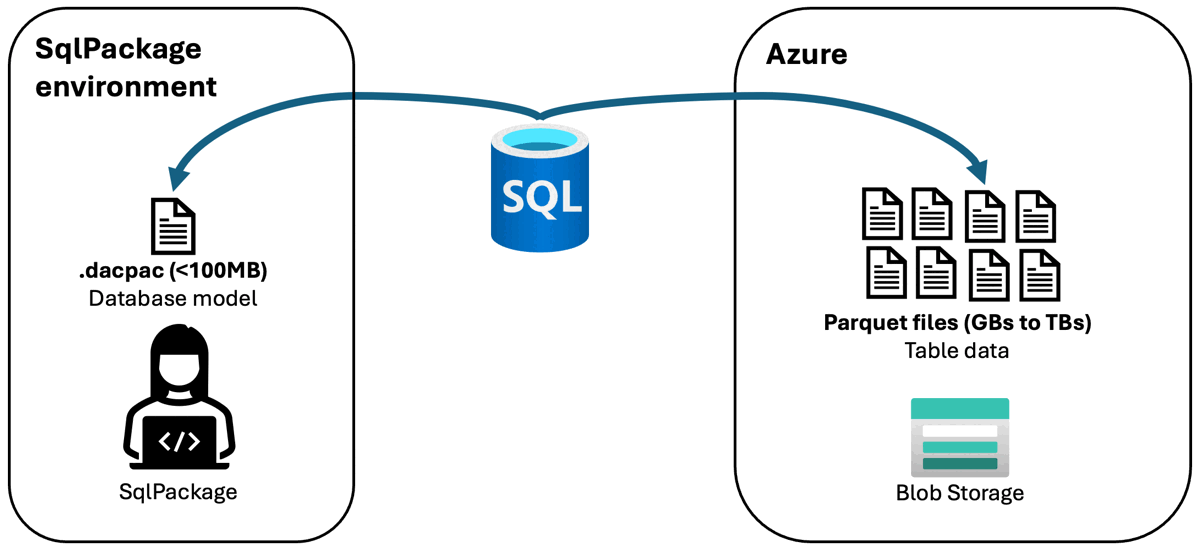หมายเหตุ
การเข้าถึงหน้านี้ต้องได้รับการอนุญาต คุณสามารถลอง ลงชื่อเข้าใช้หรือเปลี่ยนไดเรกทอรีได้
การเข้าถึงหน้านี้ต้องได้รับการอนุญาต คุณสามารถลองเปลี่ยนไดเรกทอรีได้
This article covers SqlPackage support for interacting with data stored in Azure Blob Storage that is in Parquet format.
With extract, the database schema (.dacpac file) is written to the local client running SqlPackage and the data is written to Azure Blob Storage in Parquet format. The data is stored in individual folders named with two-part table names. CREATE EXTERNAL TABLE AS SELECT (CETAS) is used to write the files in Azure Blob Storage.
With publish, the database schema (.dacpac file) is read from the local client running SqlPackage and the data is read from or written to Azure Blob Storage in Parquet format.
For SQL Server 2022 and Azure SQL Managed Instance, preview support for extract and publish with data in Parquet files in Azure Blob Storage is available in SqlPackage 162.1.176 and higher. For Azure SQL Database, preview support for publish is available in SqlPackage 170.1.61 and higher. SQL Server 2019 and earlier isn't supported. The import and export actions continue to be available for SQL Server, Azure SQL Managed Instance, and Azure SQL Database. Support for Parquet files in Azure Blob Storage continues to be generally available for Azure Synapse Analytics.
In SQL databases hosted in Azure, the extract/publish operations with Parquet files offer improved performance over import/export operations with .bacpac files in many scenarios.
Extract (export data)
To export data from a database to Azure Blob Storage, the SqlPackage extract action is used with following properties:
/p:AzureStorageBlobEndpoint/p:AzureStorageContainer/p:AzureSharedAccessSignatureTokenor/p:AzureStorageKey(not supported for use with SQL Server)
Access for the database to access the blob storage container is authorized via a storage account key. The database schema (.dacpac file) is written to the local client running SqlPackage and the data is written to Azure Blob Storage in Parquet format.
The parameter /p:AzureStorageRootPath is optional, which sets the storage root path within the container. Without this property, the path defaults to servername/databasename/timestamp/. Data is stored in individual folders named with two-part table names. The number of files created per table depends upon the MAXDOP and available SQL cores at the time of the export.
Finally, the property /p:TableData specifies which tables have their data exported. Specify the table name with or without the brackets surrounding the name parts in the format schema_name.table_identifier. This property can be specified multiple times to indicate multiple tables.
Example
The following example extracts a database named databasename from a server named yourserver to a local file named databaseschema.dacpac in the current directory. The data is written to a container named containername in a storage account named storageaccount using a storage account key named storageaccountkey. The data is written to the default path of servername/databasename/timestamp/ in the container.
SqlPackage /Action:Extract /SourceServerName:yourserver /SourceDatabaseName:databasename /TargetFile:databaseschema.dacpac /p:AzureStorageBlobEndpoint=https://storageaccount.blob.core.windows.net /p:AzureStorageContainer=containername /p:AzureStorageKey=storageaccountkey
See SqlPackage extract for more examples of authentication types available.
Publish (import data)
To import data from Parquet files in Azure Blob Storage to a database, the SqlPackage publish action is used with the following properties:
/p:AzureStorageBlobEndpoint/p:AzureStorageContainer/p:AzureStorageRootPath/p:AzureSharedAccessSignatureTokenor/p:AzureStorageKey(not supported for use with SQL Server)
Access for publish can be authorized via a storage account key or a shared access signature (SAS) token. The database schema (.dacpac file) is read from the local client running SqlPackage and the data is read from Azure Blob Storage in Parquet format.
Example
The following example publishes a database named databasename to a server named yourserver from a local file named databaseschema.dacpac in the current directory. The data is read from a container named containername in a storage account named storageaccount using a storage account key named storageaccountkey. The data is read from individual folders per table under the path yourserver/databasename/10-19-2023_11-09-56/ in the container.
SqlPackage /Action:Publish /SourceFile:databaseschema.dacpac /TargetServerName:yourserver /TargetDatabaseName:databasename /p:AzureStorageBlobEndpoint=https://storageaccount.blob.core.windows.net /p:AzureStorageContainer=containername /p:AzureStorageKey=storageaccountkey /p:AzureStorageRootPath="yourserver/databasename/10-19-2023_11-09-56/"
See SqlPackage publish for more examples of authentication types available.
Limitations
PolyBase
For SQL Server and Azure SQL Managed Instance, PolyBase is required for SqlPackage operations with Parquet files. The following query can be used to check if PolyBase is enabled:
// configuration_id = 16397 is 'allow polybase export'
// configuration_id = 16399 is 'polybase enabled'
SELECT configuration_id, value_in_use FROM sys.configurations
WHERE configuration_id IN (16397, 16399)
You might need to enable PolyBase or PolyBase export. Enabling PolyBase on Azure SQL Managed Instance requires PowerShell or Azure CLI. You should evaluate whether enabling PolyBase is right for your environment before making configuration changes.
Table and data types
Most data types are supported for extract and publish operations with Parquet files. Tables with unsupported data types result in the table data for that table being exported to the .dacpac file instead of in Parquet format. The following data types are supported and are written to Parquet files in Azure Blob Storage:
- char
- varchar
- nchar
- nvarchar
- text
- ntext
- decimal
- numeric
- float
- real
- bit
- tinyint
- smallint
- int
- bigint
- smallmoney
- money
- smalldate
- smalldatetime
- date
- datetime
- datetime2
- datetimeoffset
- time
- uniqueidentifier
- timestamp
- rowversion
- binary
- varbinary
- image
- xml
- json
- vector
Ledger tables are enabled for extract and publish operations with Parquet files.
Data stored with Always Encrypted isn't supported for extract and publish operations with Parquet files.
You can examine your database with T-SQL to detect data types that would be written into the .dacpac file instead of in Parquet files written directly to Azure Blob Storage. The following sample query returns a result set of types and tables with types not supported for writing to Parquet files.
SELECT DISTINCT C.DATA_TYPE, C.TABLE_SCHEMA, C.TABLE_NAME
FROM INFORMATION_SCHEMA.TABLES T
INNER JOIN INFORMATION_SCHEMA.COLUMNS C
ON T.TABLE_SCHEMA = C.TABLE_SCHEMA
AND T.TABLE_NAME = C.TABLE_NAME
AND T.TABLE_TYPE = 'BASE TABLE'
WHERE C.DATA_TYPE NOT IN (
'binary',
'varbinary',
'char',
'varchar',
'nchar',
'nvarchar',
'smalldate',
'smalldatetime',
'date',
'datetime',
'datetime2',
'datetimeoffset',
'time',
'decimal',
'numeric',
'float',
'real',
'tinyint',
'smallint',
'int',
'bigint',
'bit',
'money',
'smallmoney',
'uniqueidentifier',
'timestamp',
'rowversion',
'text',
'ntext',
'image',
'xml',
'json',
'vector'
);
